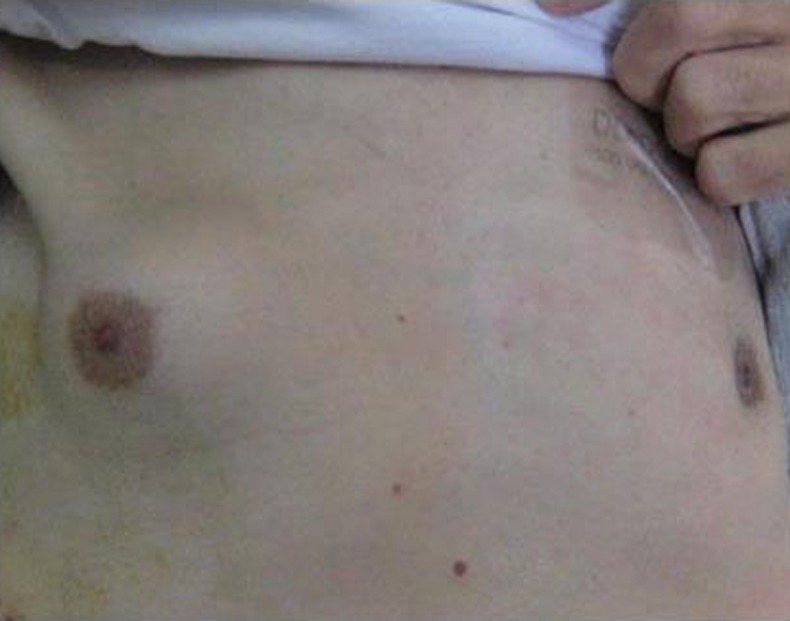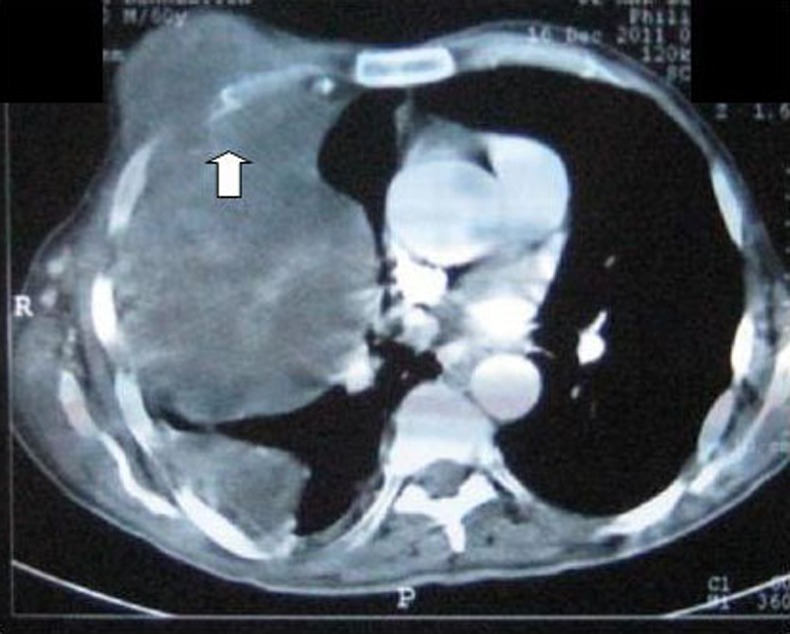Abstract
Gastrointestinal stromal tumours (GISTs) represent 1% of primary gastrointestinal cancers. These neoplasms most frequently metastasise to the liver and peritoneum and rarely to the lungs and bones. Treatment of unresectable GISTs involves systemic chemotherapy with tyrosine kinase inhibitors, imatinib and sunitinib being first-line and second-line drugs. We report the case of a 52-year-old man with GIST who developed a right-sided subareolar breast swelling and subsequently discovered to be an invasive metastatic pulmonary GIST. Given that gynaecomastia is a known adverse effect of imatinib and sunitinib, this case report illustrates the importance of including metastatic disease in the differential diagnosis of patients with GIST and with the new onset of soft tissue masses.
Background
Gastrointestinal stromal tumours (GISTs) are relatively rare non-epithelial malignancies of the intestine.1–4 The incidence of GISTs has been reported between 10 and 14 cases per million people per year.2 The stomach is the site of greatest incidence (40–70%), followed by the small intestine (25–36%).4–6 Less frequently, GISTs are found in the colon, rectum, appendix and oesophagus.4 5 Metastatic spread of GIST can occur via haematogeneous and lymphatic routes4 and the liver and peritoneum are typical sites for metastases.4 5 7 GISTs rarely metastasise outside the abdominal cavity.4 5 7 8 Here we report a 52-year-old male patient who developed hepatic, vertebral and renal metastasis following a subtotal gastrectomy for GIST and with right-sided gynaecomastia. What was initially believed to be unilateral gynaecomastia was subsequently found to be metastatic disease to the right lung.
Case presentation
A 52-year-old male patient was referred for unilateral gynaecomastia. His medical history was remarkable for a subtotal gastrectomy for a GIST at the antrum 8 years prior to his presentation.
Three years after his gastric resection, he received treatment with Imatinib (100 mg/os/day) for the presence of metastatic disease in the liver, kidney and vertebral bones. During the following years the dose of Imatinib was escalated to 400 mg/day due to progression of his disease. One year later the patient presented to the emergency department with the symptoms of chest pain and mild dyspnoea. A thorax CT was obtained which showed a heterogeneous tumour with cystic lesions in the right lower lobe of the lung leading to consolidation and collapse of the adjacent parenchyma. A cytological study of aspirated pleural fluid was positive for metastatic GIST, and Sunitinib therapy, 37.5 mg/day, was initiated. Two months later, the patient was referred with right-sided gynaecomastia accompanied by pain radiating to the axilla. Physical examination revealed a right-sided subareolar breast mass associated with axillary adenopathy (figure 1).
Figure 1.

Right subareolar mass due to metastatic gastrointestinal stromal tumour.
Investigations
Breast ultrasound showed a heterogeneous lesion containing solid and cystic components (15.5×15.8 cm in size). CT of the thorax and abdomen revealed several metastatic lung lesions (largest measuring 9×3 cm in diameter) eroding the T3–6 ribs and invading the subdermal tissue overlying the costal margins (figure 2). Biopsy and subsequent histopathological examination of the subareolar tissue and the axillary lumps showed CD 117 antigen, Vimentin (+) and CD34 antigen focal (+) tumour cells with high-mitotic activity.
Figure 2.

Intraveneous-enhanced CT of the chest demonstrating a large metastatic lung lesion infiltrating the intercostal space and the subareolar tissue of the right breast.
Differential diagnosis
Unilateral benign gynaecomastia
Breast adenocarcinoma
Metastatic tumour
Breast lymphoma
Breast abscess
Soft tissue haematoma
Treatment
Supportive palliative therapy with intravenous hydration and parenteral analgesics was initiated.
Outcome and follow-up
Three days after a central venous catheter insertion for parenteral hydration, the patient developed bacteraemia with sepsis. Empiric antibiotherapy for potential line infection (vancomycin 15 mg/kg and ceftazidime 1 g intravenously) was started without significant response and the patient subsequently expired from cardiovascular septic shock.
Discussion
GISTs typically occur in patients over the age of 40.6 Approximately, 10–30% of these neoplasms are asymptomatic and are found incidentally.4 Moreover, symptomatic tumours frequently cause non-specific symptoms2 4 5 such as vague abdominal pain, early satiety, flatulance, gastrointestinal bleeding, anaemia, fever, night sweats, weight loss, nausea and vomiting.2 4
In the past, these tumours were grouped within the class of leiomyosarcoma.2 Over time, immunohistochemistry techniques have shown that GISTs do not exhibit immunohistochemical staining typical for leiomyosarcomas.2 3 Instead, 95% of GISTs express the c-kit (KIT) receptor tyrosine kinase (CD 117 antigen) and 60–70% express CD 34 antigen,2–4 suggesting that GISTs originate from a mutation in the KIT proto-oncogene of a pluripotent precursor cell of the interstitial cells of Cajal.2–4
Surgical excision remains as the only curative treatment for non-metastatic GISTs3–9 and 5-year survival ranges between 48% and 70%.3–9 Recurrence even after radical resection occurs in 17–21% of patients and the mean survival after recurrence is only 9–20 months.3 4 9
Imatinib has been used in neo-adjuvant and adjuvant setting to improve the resectability and overall survival in high-risk patients.2 3 7 In the event of intolerance or tumour resistance to imatinib, sunitinib has been approved as a second-line therapy.3 10–12
Extra-abdominal metastases are rare.5 Exceptionally rare are metastases of breast or other soft tissues. Therefore, this case represents a very unique clinical presentation of an advanced metastatic GIST tumour that posed a diagnostic challenge because gynaecomastia represents an adverse effect of both imatinib and sunitinib.13–17
To our knowledge, this is the only reported case of gynaecomastia due to metastatic GIST and should be considered in the differential diagnosis of patients with stage IV disease.
Learning points.
Although rare, bilateral gynaecomastia has been described in patients undergoing chemotherapy with imatinib and sunatinib.
It is believed that the inhibition of the platelet-derived growth factor and KIT receptors in testicular cells by these drugs leads to decreased biosynthesis of testosterone, thereby facilitating development of gynaecomastia.13
Unilateral gynaecomastia in these patients should raise the suspicion of metastatic disease.
Acknowledgments
The authors would like to thank Dr Hulagu Kargici.
Footnotes
Contributors : SGC was involved in case report writing and identification of the patient. FM, SC and MM were involved in case report writing.
Competing interests: None.
Patient consent: Obtained.
Provenance and peer review: Not commissioned; externally peer reviewed.
References
- 1.Pandurengan RK, Dumont AG, Araujo DM, et al. Survival of patients with multiple primary malignancies: a study of 783 patients with gastrointestinal stromal tumor. Ann Oncol 2010;21:2107–11 [DOI] [PMC free article] [PubMed] [Google Scholar]
- 2.Judson I. Gastrointestinal stromal tumours (GIST): biology and treatment. Ann Oncol 2002;13(Suppl 4):287–9 [DOI] [PubMed] [Google Scholar]
- 3.Rajendra R, Pollack SM, Jones RL. Management of gastrointestinal stromal tumors. Future Oncol 2013;9:193–206 [DOI] [PubMed] [Google Scholar]
- 4.Cichoz-Lach H, Kasztelan-Szczerbinska B, Slomka M. Gastrointestinal stromal tumors: epidemiology, clinical picture, diagnosis, prognosis and treatment. Pol Arch Med Wewn 2008;118:216–21 [PubMed] [Google Scholar]
- 5.Ozan E, Oztekin O, Alacacioglu A, et al. Esophageal gastrointestinal stromal tumor with pulmonary and bone metastases. Diagn Interv Radiol 2010;16:217–20 [DOI] [PubMed] [Google Scholar]
- 6.Pasku D, Karantanas A, Giannikaki E, et al. Bilateral gluteal metastases from a misdiagnosed intrapelvic gastrointestinal stromal tumor. World J Surg Oncol 2008;6:139. [DOI] [PMC free article] [PubMed] [Google Scholar]
- 7.Kroep JR, Bovee JV, van der Molen AJ, et al. Extra-abdominal subcutaneous metastasis of a gastrointestinal stromal tumor: report of a case and a review of the literature. J Cutan Pathol 2009;36:565–9 [DOI] [PubMed] [Google Scholar]
- 8.Jones AP, Allison K. Subcutaneous metastasis of a GIST tumour unresponsive to Imatinib. J Plast Reconstr Aesthet Surg 2011;64:e250–1 [DOI] [PubMed] [Google Scholar]
- 9.Canda AE, Ozsoy Y, Nalbant OA, et al. Gastrointestinal stromal tumor of the stomach with lymph node metastasis. World J Surg Oncol 2008;6:97. [DOI] [PMC free article] [PubMed] [Google Scholar]
- 10.Demetri GD, van Oosterom AT, Garrett CR, et al. Efficacy and safety of sunitinib in patients with advanced gastrointestinal stromal tumour after failure of imatinib: a randomised controlled trial. Lancet 2006;368:1329–38 [DOI] [PubMed] [Google Scholar]
- 11.Demetri GD, Garrett CR, Schoffski P, et al. Complete longitudinal analyses of the randomized, placebo-controlled, phase III trial of sunitinib in patients with gastrointestinal stromal tumor following imatinib failure. Clin Cancer Res 2012;18:3170–9 [DOI] [PMC free article] [PubMed] [Google Scholar]
- 12.Schramm N, Englhart E, Schlemmer Met al. Tumor response and clinical outcome in metastatic gastrointestinal stromal tumors under sunitinib therapy: comparison of RECIST, Choi and volumetric criteria. Eur J Radiol 2013;82:951–8 [DOI] [PubMed] [Google Scholar]
- 13.Tanriverdi O, Unubol M, Taskin F, et al. Imatinib-associated bilateral gynecomastia and unilateral testicular hydrocele in male patient with metastatic gastrointestinal stromal tumor: a literature review. J Oncol Pharm Pract 2012;18:303–10 [DOI] [PubMed] [Google Scholar]
- 14.Ballardini P, Margutti G, Aliberti C, et al. Onset of male gynaecomastia in a patient treated with sunitinib for metastatic renal cell carcinoma. Clin Drug Investig 2009;29:487–90 [DOI] [PubMed] [Google Scholar]
- 15.Kim H, Chang HM, Ryu MH, et al. Concurrent male gynecomastia and testicular hydrocele after imatinib mesylate treatment of a gastrointestinal stromal tumor. J Korean Med Sci 2005;20:512–15 [DOI] [PMC free article] [PubMed] [Google Scholar]
- 16.Gambacorti-Passerini C, Tornaghi L, Cavagnini F, et al. Gynaecomastia in men with chronic myeloid leukaemia after imatinib. Lancet 2003;361:1954–6 [DOI] [PubMed] [Google Scholar]
- 17.Zhao D, Wang G, Li C, et al. Bilateral masculine mastoplasia associated with imatinib mesylate: a case report and literature review. J Huazhong Univ Sci Technolog Med Sci 2011;31:145–6 [DOI] [PubMed] [Google Scholar]


